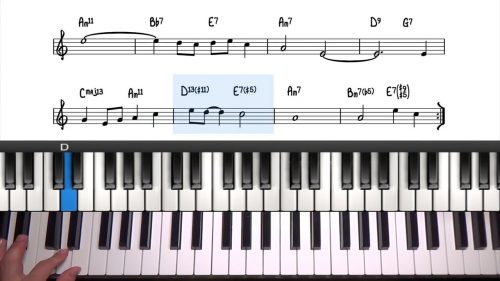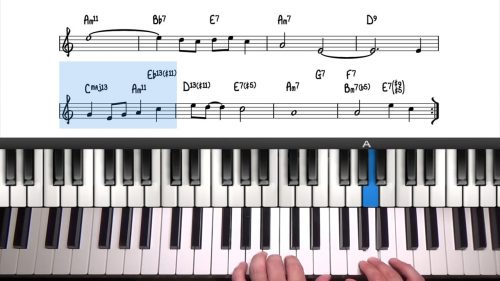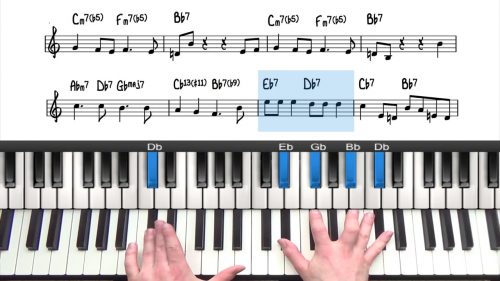Summertime Advanced Arrangement
Welcome to part 2 of this lesson on "Summertime" vocal accompaniment. In part 1, we explored a basic version of the form and the chord changes. We also introduced a walking bassline outlining the root and 5ths of each chord.
In this lesson, we will introduce extended and altered chord voicings to create a richer and more sophisticated accompaniment.
Summertime Bassline & Voicings
In our situation, the left hand will be playing the bassline and the vocalist will be singing the melody. This leaves our right hand free to experiment and explore the more colourful tones and tensions.
We will keep the bassline consistent with the previous lesson, and so I’m going add voicings that fit well with both the baseline and the melody.
We will be incorporating some of the voicings from the solo piano arrangement of this tune. We’ll still need to be mindful of clashing extensions and reharmonizations as discussed earlier in this course. In places, we’ll need to simplify the voicings, and only add in complex colors in melodic breaks, or where we’ve worked it out that it will sound good with the melody.
Summertime Sing & Play
If you are the singer and the pianist, it’s a little easier to coordinate voice to piano and experiment with the tunes you are playing. You can follow this exact process for all of your songs. Check out the next lessons in this course for tips and advice specifically for the singing pianist.
This lesson provides a track where I’ll sing in Dmin with simple bass and metronome. You can play along and try out different basslines, voicings and fills. I’ll go thru the form 4 times, once with the lyrics you’ve heard me singing, then I’ll scat, then I’ll come in with the first verse again, and then I’ll get to sing my very most favorite verse of any jazz standard – the 2nd verse of summertime.
Practice Tips
-
When introducing extensions and alterations, be mindful of clashes with the melody as discussed in earlier lessons in this course.
-
Simplify the chord changes and only add complex colors in melodic breaks, or where you have worked out that it will complement and enhance the melody.
-
You have all the creative license to work out your own version of this song.
- You are welcome to use the chords and ideas covered in this tutorial, but also ensure that you are listening and transcribing from your favourite versions of the tune.





Hi Lyndol. This was a fun one to work through. Question on the F# dim chord (4th bar): at minute 5:52, you played the F# note in the bass, but at minute 13:28, it’s played with ‘A’ in the bass. Is that assumed that the bass player has the F# covered? or is it generally OK to play different bass note as long as it’s in the chord? thanks
Hi Joel,
So glad you enjoyed it.
Diminished chords are versatile in terms of how to voice them. Every diminished 7th chord has a repeating interval pattern of minor 3rd intervals. So the diminished 7th chord is simply a stack of minor 3rd intervals.
If you take the bottom note, and place it on the top, again you will see it’s a minor 3rd interval. This gives you a lot of freedom when voicing these chords because they sound is very similar in each inversion because the interval relationship starts the same in any inversion.
This is why I played it with F# on the bottom the first time, and then with A on the bottom. The sound is very similar and so you have the freedom to voice diminished chords in these different inversions.
In addition to this, the F#dim7 chord that you are seeing, is actually functioning as a rootless D7b9 chord (which is the previous chord). For any dominant chord, you can build a diminished 7th off the major 3rd, and it will give you a rootless 7b9 chord. If you analyse the notes of F#dim7, you will see that it contains the ‘essential chord tones’ of D7 which is the major 3 and b7, and then also the 5th and the b9.
The best way to look at that diminished chord, is a rootless variation of D7, and so in that sense, you can play the F#dim7 in any inversion because it is functioning as a rootless D7b9.
I’d recommend you check out Hayden’s lesson on diminished chords here: https://www.pianogroove.com/jazz-piano-lessons/understanding-diminished-chords/ where he explains in more detail.
You can also check out Hayden’s tutorial on Summertime, where he explains this progression: https://www.pianogroove.com/jazz-piano-lessons/summertime-walking-bass-line-tutorial/ – remember that Hayden covered the tune in A Minor, and so the key is different, but similar voicings were used in both arrangements.
To address the question of whether or not you always need to have the root in the bass when accompanying a singer…
If you are playing with a bassist, then you are free to play rootless voicings as much as you like. The burden of establishing the tonality and harmony (clearly for the singer thru rooted bass) is covered by him/her.
If you are playing without a bassist, then you must make sure the tonality is established. So yes, playing the Root in the bass is the surest way to do this.
But it’s not a strict rule, you can step out of this pattern in various places to keep it interesting. It’s up to your discretion on where, and how often to do a rootless bass note. I find diminished chords can be a nice place to do this, given the nature of their structure and sound.
My rule is when in doubt, play it safe and stick with the root. But the more you experiment with a song arrangement, the clearer it will become to you where you can step out and still keep the tonality clear. Does this answer your question? Please don’t hesitate ask more questions if not.
– Lyndol